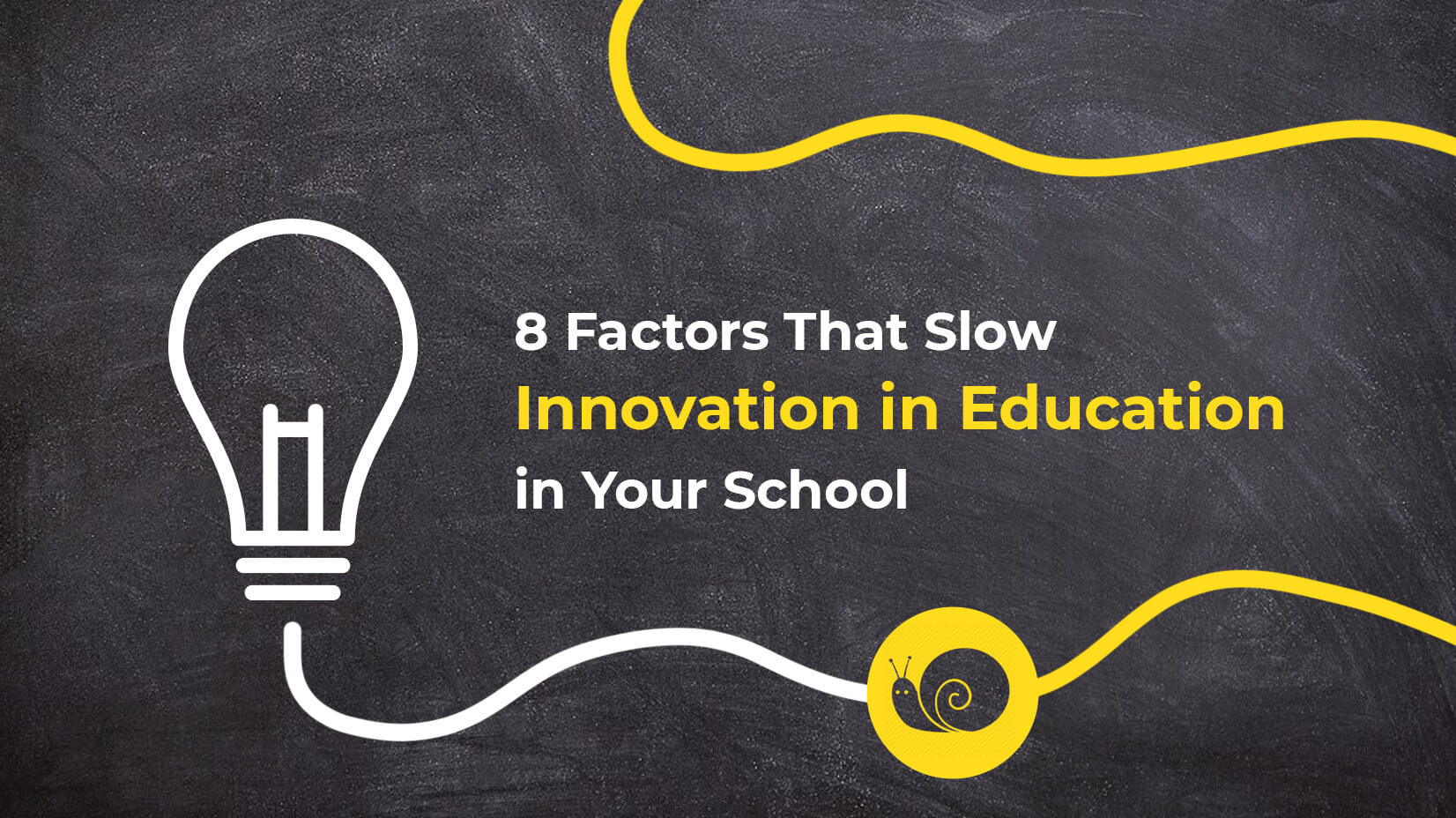
Innovation in education is a crucial process not only because schools need it. Humankind needs it. Innovation in education is unarguably a huge driving force to the evolvement of people and a factor that optimizes the learning processes and revolutionizes the whole educational system. We are already witnesses of amazing innovations which steadily enter the educational institutions and completely transform the traditional teaching methods as we know them.
However and regardless of how many benefits innovation in education may have for the future generation of students, there are still some factors that slow down and even sabotage this process. Some of them are pretty unexpected. Let’s see.
Article overview:
Factor 1: The reluctance of parents to accept innovations
Factor 2: The lack of parental involvement
Factor 3: The disunity of the school council
Factor 4: A wrong focus at school meetings
Factor 5: A quick turnover of teachers
Factor 6: Teachers overloaded with work
Factor 7: Scripted curriculum materials
Factor 8: Ineffective guidance from experts
You may also be interested in The Best Online Learning Platforms in 2022
Factor #1
The reluctance of parents to accept innovations

Source: Unsplash
It’s natural that parents want the best for their children. And this is great. What is not so great, though, is that there are many parents who believe that old teaching methods are actually the best for their children. The reluctance of parents to accept new, innovative ways of teaching is certainly a major problem that keeps innovation in education from entering the classrooms, especially when these parents are parts of school committees and their vote actually counts.
As parents do not agree with teachers’ efforts and ideas to introduce, lets’ say, gamification or virtual reality, or any other innovational technology in the classroom, they don’t really think they harm the development of education, at all. They genuinely do not see the benefits from it or are too stubborn to accept that new methods may make teaching more interesting for children, and therefore, more effective.
Factor #2
The lack of parental involvement

Source: Unsplash
When it comes to innovation in education, teachers will most definitely not only need the support of parents but their cooperation, too. As a rule, young generations are more open to novations, so transitions to new methods are usually easier for students rather than teachers and parents. But it is exactly the older generation’s task to help the young ones take these changes seriously.
Unfortunately, parents are often too busy to be actively involved in the education of their children. Especially when speaking of single parents who have to work two jobs in order to support the family. As much understanding, necessary, and unfortunate as this situation may be, it stands in the way of some advancements in education that require the involvement of parents. To the least, maintaining regular communication with your children and teachers and giving your full moral support will give teachers green light to trigger innovative processes in the classroom.
Factor #3
Disunity of the school council

Source: Pixabay
School councils, whose members are representatives of educators and parents, are responsible for important decisions regarding the school, class activities, teachers, teaching processes, etc. Since each decision is made by voting, it’s very often that members of councils are not on the same page about suggested innovations. Naturally, this delays and even completely block the processes of implementing these innovations in the classroom.
On the one hand, you have the unflexible “traditionalists” who stick to their favorite old ways and believe that if these methods worked back then, they will definitely work now with the same efficiency. On the other hand, you have the “enthusiasts” who are really eager about innovations in school but don’t really have the expertise and skills to implement them. And very often, the real innovators who are capable of doing so are often not even on the council.
Factor #4
A wrong focus at school meetings

Source: Pixabay
Poorly managed meetings, be it between teachers or between teachers and parents, often lead to little or no results regarding innovation in education. Simply because this subject is not within their focus. The subjects discussed at meetings are rarely related to optimizing learning processes rather than students’ behavior, for example. Members of school meetings do not always realize that innovation in education is crucial and it is the solution to many of the challenges they face.
Another problem is teachers and parents know something has to be done but they don’t know how. So, instead of focusing on how to practically implement innovations in school and make them work, they often discuss subjects of secondary importance which definitely delays innovation in education.
Factor #5
A quick turnover of teachers

Source: Unsplash
Sometimes, replacing teachers is a step forward to innovation in education. However, if this measure is taken too often, it doesn’t do any good for anyone. It has an especially negative impact on students who need time and energy to adapt to their new educator each time instead of redirecting this energy to studying.
When educational institutions focus more on searching for new teachers who will “bring in” innovations in class rather than investing time and resources in educating their staff, then processes of implementing innovation in the school are definitely slowed down.
Factor #6
Teachers overloaded with work

Source: Pexels
A very common factor that stands in the way of innovation in education is teachers who are overloaded with work. Rushing between classes and meetings, planning class activities, following the curricula while striving to stay creative, assessing endless piles of paperwork… Add trying to maintain a good balance between personal and professional life to the equation.
It’s not hard to figure out that teachers with schedules like this definitely have the potential to bring innovation to the classroom. However, they hardly have time to complete their current tasks, let alone put aside time to plan innovations
Factor #7
Scripted curriculum materials

Source: Pexels
Well, this methodology can successfully be used as an antonym of innovation in education. Personification being one of the key factors innovation in education focuses on, is quite the opposite of the idea of scripted curricula.
As much as a scripted curriculum may give educational systems the feeling of control and equality across schools, it detracts from teachers’ creativity and personal approaches. And undoubtedly, the latter factors are crucial for the classrooms of the future and the effectiveness of education whose demands are definitely changing.
Factor #8
Ineffective guidance from experts

Source: Pixabay
Sometimes the schools do realize the need of bringing innovation into the classrooms and parents fully support this decision. Even when schools actually take steps towards implementing innovation and invite professionals to provide teachers with experience and advice, the transitions to the new teaching methods may not go as planned or very smoothly. Even worse, the whole initiative may completely fail.
The problem is hidden in the way of transmitting the knowledge or should we say – the way of not transmitting the knowledge. Very often, this is where the educational system fails. They are not able to provide school teachers with a method like a cognitive apprenticeship but instead, they provide them with tons of information that teachers cannot successfully apply in the classroom. As a result, innovation in education simply cannot happen.
To wrap up,
Innovation in education is a process that must happen continuously. Unfortunately, instead of making this process faster, sometimes it’s the teachers, parents, the community, and the whole educational system that slows it down or even sabotages it. The solution may be complex but the first step is realizing the problem. Any thoughts on the subject?
Continue with some of these related articles:
- 25 Free Education PowerPoint Templates For Lessons, Thesis, and Online Lectures
- The 25 Education Tools Teachers Need To Know About (Apps, Extensions, and Platforms)
- Why & How to Use Motion Capture for Education














